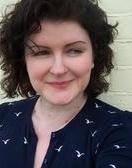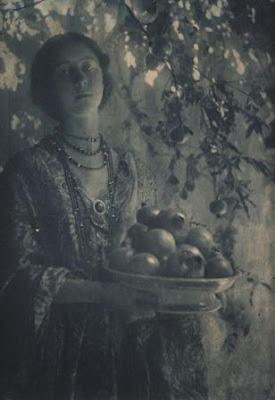
Decorative Study (c.1906) Mina Keene
Full disclosure: I went first thing on a Friday morning and spent a ridiculous amount of time in there. This was mainly because it was empty, which was worrying, especially as it was half term. However, the lack of other people did mean I could get a good view of everything and stand and stare for as long as I liked without getting elbowed or tutted at. You can also get as close as is decent to see things you might have missed so I got within licking distance (technical term) of The Death of Chatterton and saw, for the first time that one of his shoes had fallen off. Also, I had never thought about the fact his jacket is a pinky red color. Really? With that hair?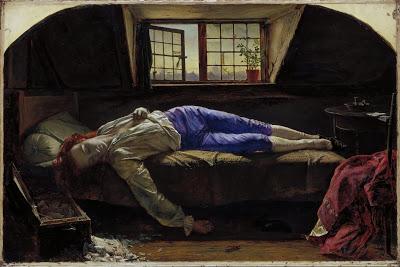
The Death of Chatterton (1856) Henry Wallis
Note: shoe under the bed, off his right foot
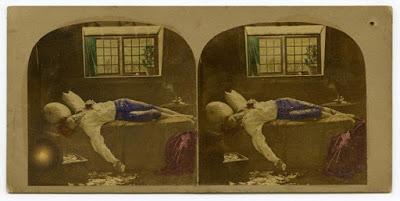
The Stereoscope of Chatterton...
Delicious Chatterton was there because of a rather lovely stereoscope image of him. It proved so popular that the engravers who were making a fortune from engravings of the expiring poet took the stereoscope people to court to protect their business. I mean, who wouldn't want to see a 3D Chatterton? Blimey...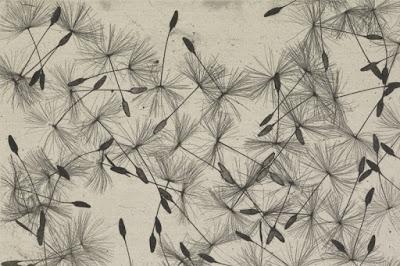
Dandelion Seeds (1852-7) Henry Fox Talbot
However, I am getting ahead of myself. The first rooms of the exhibition feature earlier, less 'fancy' uses of the bright new craft of photography. There are a number of impressively sharp cityscapes of Edinburgh taken by David Octavius Hill, a painter in search of an edge. The photographs contrast well with the more powdery impressionism of Turner's idyllic visions, but I have to admit to preferring Hill's photographs to the precise paintings he produced from them. Possibly the most impressive, if only in scale, painting in the exhibition greets you as you enter. The Disruption Portrait, impossible to reproduce here due to the sheer scale of it, shows the first General Assembly of the Free Church of Scotland signing the Act of Separation and the Deed of Demission in 1843. There are 457 individual portraits, all crammed in to a room, some looking down from holes in the ceiling and each one is based on a photograph. It is astonishing but rather too much to cope with, so I prefer the portrait and self portrait of William Etty...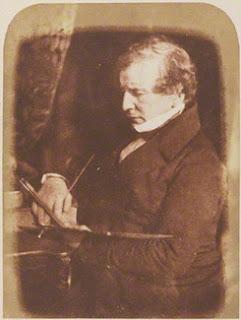
William Etty (1844) David Octavius Hill and Robert Adamson
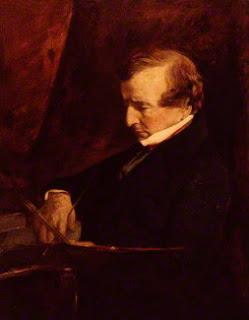
Self Portrait (1846) William Etty
When Etty was in Edinburgh for a Scottish Royal Academy dinner, Hill and Adamson convinced him to have a photograph taken. He then took that as the basis of a self portrait but it was unusual because he was not looking out at us (as he would have been if he was painting from a mirror). The result is the ability to paint oneself in repose and 'unaware' of the viewer's gaze which feels very modern and also makes the best of his rather splendid profile. That is an impressive nose...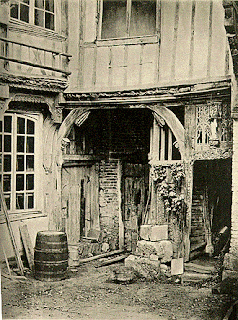
The Courtyard of a Late Gothic Wooden House at Abbeville (1868) John Ruskin
It really shouldn't come as a surprise that the Pre-Raphaelites are such natural bedfellows with photography, after all what could be more 'truth to nature' than a photograph? John Ruskin's very impressive photographs feature in the exhibition, and it seemed that very quickly the idea of using photographs to get the desired verisimilitude into your work was essential. There are a number of paintings of the Holy Lands by Thomas Seddon and William Holman Hunt, together with photographs of various settlements on show. We know that when Hunt started showing the Holy Family as, well, a Middle Eastern Jewish family, there was outrage and one can only imagine the same was true of the landscape which was completely different to England. The photographs of Nazareth act as both an aide-memoire for the artists but also a sort of proof of the existence of God, because I suppose the average British church goer had no clue, beyond their illustrated Bible, what the Holy Land looked like. Photographs of towns filled with flat roofs and occasional minerettes give tangible existence to the stories that were set there and truth to the images painted from there. The only thing that I miss in the photographs is that hot volcanic sky that Hunt shows, all swirls of pink in the blue, the lurid result of erupted gases (if you excuse the expression). The photographs are a wonderful record but miss the essential life of the area. However, as I moved on through the exhibition, things certainly came to life...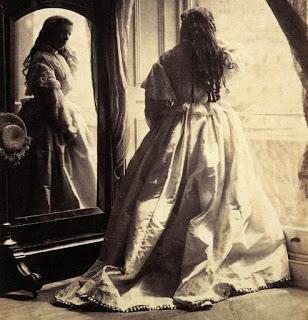
Isabelle Grace Maude (1862-3) Clementina Lady Hawarden
Slightly shamefully I must admit that I far prefer images of people to still life and landscape. I feel an instant connection and involvement and so the parts of the exhibition that dealt with pictures such as Lady Hawarden's claustrophobic images of studied female repose held me utterly captivated. Whilst very theatrical and self conscious, Lady Hawarden's repetition of female figures in sparse rooms, fluttering at the window-light like butterflies feel more dreamlike than posed, unlike Roger Fenton's output, or Edward Linley Sambourne's photographs of the rather naked Ethel Warwick. Hawarden's work stands out in the room because there does not seem to be the desire to record in detail for 'academic purposes' (she says, with a raise eyebrow). My favorite 'academic purpose' image has to be Rose the Model...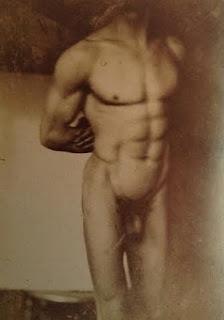
Rose the Model (1865) Samuel Butler
Well, heavens to Betsy! Everybody get a firm hold on their academic purposes and we shall continue. There was a feeling that the human body should be recorded to compare with classical sculpture and this is certainly the case with Rose (which I'm guessing is the chap's last name) and his very impressive regions. We obviously don't need to see his face (the phrase about not looking at mantlepieces while stoking fires comes to mind) but the record of his muscles is amazing. I wonder what he did for a living?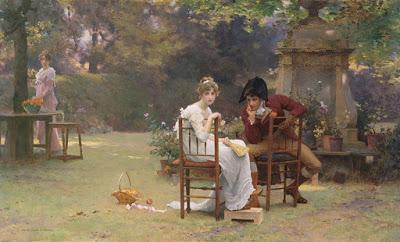
Two's Company, Three's None (1892) Marcus Stone
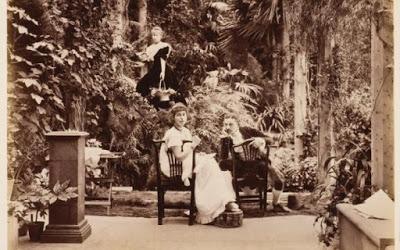
HRH Princess Alexandra, HRH Princess Victoria & Mr Savile (1892-3)
Moving on swiftly, we come to my favorite bit of the exhibition, the recreation of (and inspiration by) paintings in photographs. There seemed a bit of a vogue for being photographed in the manner of a painting in a tableaux vivant, as shown above by Princesses Alexandra and Victoria (and the lucky Mr Savile) recreating Marcus Stone's melancholic Two's Company, Three's None, obviously for their own amusement, but some people took it very seriously. It seems the Moxon Tennyson had a lot to answer for...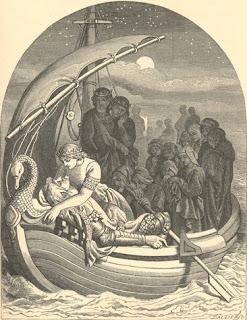
Morte D'Arthur (1857) Daniel Maclise
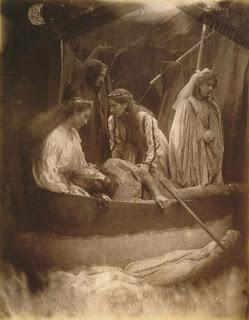
The Passing of Arthur (1875) Julia Margaret Cameron
There was obviously something about the illustrations to Tennyson's poems that inspired photographers because Cameron wasn't the only one to call on them for inspiration. The exhibition also shows Lady Hawarden's destraught daughter in the pose Millais Mariana, also from Moxon, as well as Henry Peach Robinson's Lady of Shalott with her heavily crimped hair.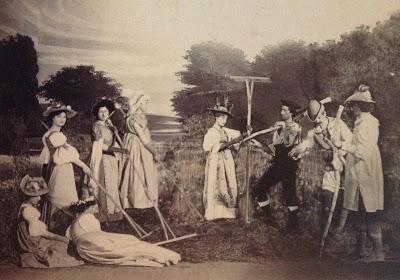
Living Picture: Pastoral Scene (1896) Arranged by Walter Crane
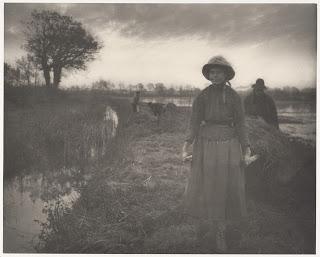
Poling the Marsh Hay 1885-6 (1887) Peter Henry Emerson and Thomas Frederick Goodall
Not all are wonderful however and I found some of the aesthetic 'rural' idylls to be appalling, as opposed to the realist works of Peter Henry Emerson and Thomas Frederick Goodall. I wrongly assumed that Crane's vision pre-dated the Norfolk scenes and could be excused by a lack of technology, but quite the opposite. Emerson and Goodall show life from a decade before Cranes' studio arrangement. Maybe there was something about the work of such artists as George Clausen in the 1880s that lent itself more sympathetically to the medium of photography, unlike the very stylistic and mannered unreality of aesthetic art. Whatever the reason the Crane picture looked like a publicity shot from a bad amateur theatrical unlike Emerson and Goodall who seem to be making a Thomas Hardy documentary...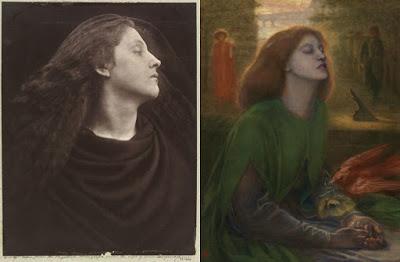
Call, I Follow, I Follow, Let Me Die (1870-75) Julia Margaret Cameron and
Beata Beatrix (1864-70) Dante Gabriel Rossetti
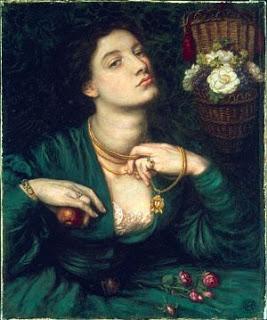
Monna Pomona (1864) Dante Gabriel Rossetti
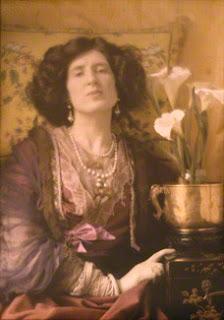
Lady Ottoline Morrell (c.1907) Adolph de Meyer
The last few pages of notes I took in the exhibition are basically me exclaiming over the beauty of the images such as Adolph de Meyer's portrait of Lady Ottoline Morrell. I am a sucker for autochrome and the Tate have displayed some of the images on lightboxes which made me slightly incoherent with pleasure at the luminous beauty of it all. If you ever had doubts that photography was an art form, the final room especially will convert you. William A Stewart's Ex Umbris echoes Orpheus and Eurydice but also is a touching and erotic image of love and death, so coverted by the Victorians.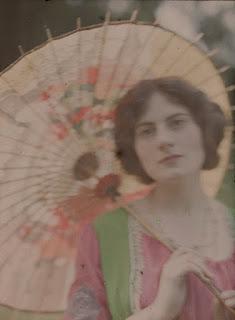
The Japanese Parasol (1906) John Cimon Warburg
Photography pushes the boundaries of decency whilst mirroring high art and to see the two together is disconcerting but fascinating. The genius of the exhibition is that you have room after room of the story of art photography from Fox Talbot's dandelion seeds to Lady Ottoline and her lilies with a coherent and inspiring narrative of how we got there. The photographs used are beautiful and the paintings are well-chosen and familiar enough to be reassessed in a different context.
Prosepine (1874) D G Rossetti and The Odor of Pomegranates (1899) Zaida Ben-Yusuf (details)
The catalog is surprisingly cheap at £15 and beautifully illustrated although not everything in the exhibition is in the catalog (as far as I can see) so I urge you to experience both if at all possible. It is certainly the best exhibition I've seen at the Tate for a while and surprised me in both its interpretation and how much gleeful giggling I did. Despite the entry fee, I am hoping to see it again during the summer because it is just so good.Painting with Light is on until 25th September and further details can be found here.
